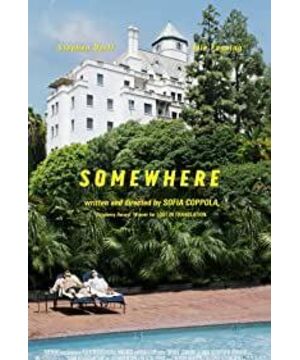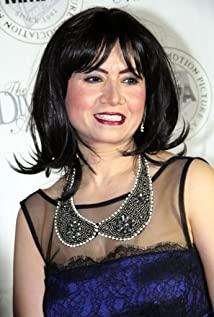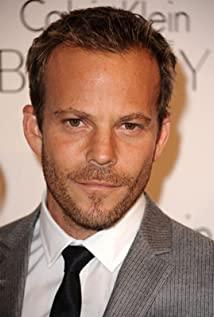Why is this happening? If I love "Lost in Tokyo", then there is no problem that I cannot accept Sofia Coppola's photography and narrative style. But the perspective was moved from a middle-aged actor (Bill Murray) living in a foreign hotel to an idol star at the Charlottemont Hotel in Hollywood. Why did the previous humor and sadness turned into boring?
This probably starts with a clip of the star life of the protagonist Johnny (Stephen Dorff). Sophia Coppola used many minutes of objective long lens in the film, such as the opening of Johnny driving his black convertible Ferrari to patrol alone on the sand outside Los Angeles, or Johnny called Pole dancing sisters come to their rooms for private performances. Johnny’s Ferrari is very cool, and the pole dancing sisters Hua’s performances are also very hard, but the single-camera + repetitive single action makes the amount of information brought out by the lens very limited, and it mainly conveys a kind of emotion— —Johnny's life is dull and boring. So far, the rhythm of the film matches its mood.
The change in Johnny's life began with the appearance of his daughter Elle Fanning. According to the general narrative marching convention, if the film begins to have a slow and dull rhythm, then there must be surprises in the back, or the rhythm is accelerated, or the shock of emergencies, correspondingly, there will be changes in the photography technique to some extent. The lens transitions to more frequent viewing angle switching, which increases the amount of lens information and creates a sharp contrast effect. But "Somewhere" is not there. The interaction between Creo and Johnny is still restrained, it is the natural accumulation of daily trivial matters, there is no dramatic exaggeration, and there is no agitated father-daughter relationship. Such bland and casual clips are very difficult to shine on the big screen, because they are almost as dark and depressing as life itself. There is no spotlight, no cheers, and the director's perspective is the whole key.
In this case, if we still adopt the editing method based on long shots, how can we attract the attention of the audience, and let people be grateful and moved by a seemingly calm story?
Sophia Coppola's "Lost in Tokyo" is a perfect example. The middle-aged actor Bob in the story is in a foreign land, and the setting of Americans in Tokyo itself is novel and interesting, and the jokes are uninvited; Bill Murray is full of scenes, with the beautiful Scarlett Jonhansson staged a scene if nothing happens. The relationship between men and women has a broad foundation for resonance with the audience. In the absence of changes in the lens technique, the content of the story itself becomes extremely important. Among them, the slow rhythm of the long lens is adjusted by the method of shaking baggage and adding jokes, which can achieve the sense of rhythm of the lens brought by the editing. It forms a natural, relaxed and orderly narrative rhythm, which will not be uncomfortable to drag; and in order to highlight the loneliness of the traveler's homesickness, many scenes are arranged in group dramas, which invisibly increase the amount of information conveyed by the lens. Under such a setting, the shortcomings of the long lens are made up for by the advantages of the story content, and its advantages in portraying the mood and atmosphere have been fully utilized. The result is a moving and good work, elegant and refined, but the art is not artificial.
"Somewhere" is a pity the opposite. Sophia Coppola adopts the same "third eye" long lens technique in the second half of the movie, which is exactly the same as the first half, but there is no natural attraction between Johnny and Clio’s father-daughter interaction. . Whether it’s a trip to Italy or the Chatemont Hotel in Hollywood, Johnny is like a stranger outside the environment. He has no cultural conflicts with the outside world, nor can he talk about genuine exchanges, even in his own life. Almost an unfamiliar spectator, everything faded. When pushed by life, Johnny took a step forward. No one pushed, he would be lazy, so lazy that he could see him falling asleep while watching the pole dancing. Even with daughter Creo, some of the tensions that could have been dramatized (the relationship between Creo and Johnny’s bed lover, or the relationship between Johnny and Creo’s mother) and emotional catharsis are in Sofia Kobo Ra’s perspective is also full of dots. To understand the inner world of these characters, the audience has to work hard to fill in the blanks; but unfortunately, at least for me, the overall setting of "Somewhere" and Johnny This boring character makes me feel uninterested to devote myself to emotions. In this environment where millions of people are unemployed, Johnny’s boring loneliness and loss of life’s confusion seem so light and fluttering. How does it resonate?
Therefore, for me, this "Somewhere" is really ugly-the rhythm is monotonous, the information is thin, and the form is boring. Even the fresh and refined Elle Fanning can't restore the overall tone of the film's slow groan. But I think this is not the fault of the long lens itself, nor is there a problem with Sofia Coppola's style, but the wrong object for the long lens and the wrong timing for the style. This is a negative teaching material used by a long lens.
View more about Somewhere reviews











